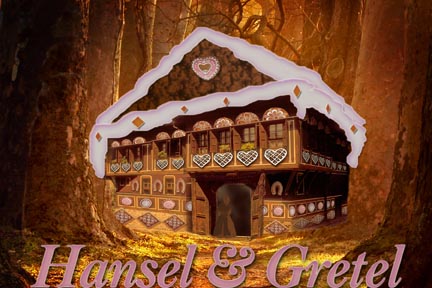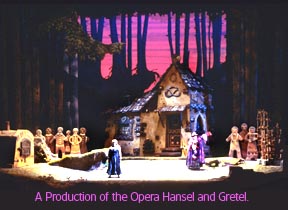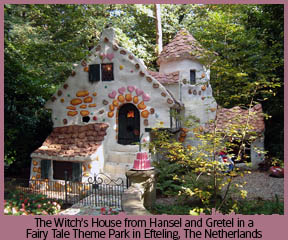
Wanted for murder: Haensel and Gretel:
Behind the classic Christmas-season fairy tale is a gruesome true story of entrepreneurial greed
by Anke A. Culver
 During the time of Advent and Christmas, nearly every German town offers an annual "Christkindlmarkt" where hot mulled wines and gingerbread houses are sold along with other regional foods. The market is usually nestled next to a medieval church in the town's center, bringing back memories of sugar plums and gingerbread cookies and reminding us of "Haensel and Gretel," the German fairy tale written by the Brothers Grimm at the beginning of the 19th century. There is nary anyone in the world who is unfamiliar with this exciting story of two lost children in an enchanted forest, be it the Grimm's version or the Engelbert Humperdinck opera. During the time of Advent and Christmas, nearly every German town offers an annual "Christkindlmarkt" where hot mulled wines and gingerbread houses are sold along with other regional foods. The market is usually nestled next to a medieval church in the town's center, bringing back memories of sugar plums and gingerbread cookies and reminding us of "Haensel and Gretel," the German fairy tale written by the Brothers Grimm at the beginning of the 19th century. There is nary anyone in the world who is unfamiliar with this exciting story of two lost children in an enchanted forest, be it the Grimm's version or the Engelbert Humperdinck opera.
German children know all too well the cruelty of the bad witch who traps two lost children in her gingerbread house, locking them up with the intent of fattening and roasting them for her consumption. But Haensel and his sister, Gretel, outsmart the witch and roast her in her own oven. The children end up with the treasures and riches of the witch and return home to their father, who is remorseful that he had left the children in the woods to fend for themselves. But now the children's evil stepmother -- who had pushed the father to abandon the children -- has died, and the children and the father live happily everafter.
This is the story as told by Jacob and Wilhelm Grimm in 1812. But in 1962, a teacher by the name of George Ossegg went about unearthing an earlier and much different story of Haensel and Gretel. His methodical research included excavations in the Spessart Forest not far from the city of Frankfurt/Main.
MURDERERS BECOME INNOCENTS
The Grimm Brothers, natives of Hanau, Germany, collected folktales which had been handed down from generation to generation by word-of-mouth. But they often changed these stories to better conform to the prevailing ethics of the early 19th century.
 "Haensel and Gretel" is a case in point. In the Grimm fairy tale, we feel sympathy for the abandoned children caught in the unpenetrable forest. They are presented as victims of heartless parents and a cannibalistic witch. But, as Ossegg discovered, the real story of Haensel and Gretel, upon which the fairy tale was based, was a story of murder and entrepreneurial espionage in which the witch is the true victim. "Haensel and Gretel" is a case in point. In the Grimm fairy tale, we feel sympathy for the abandoned children caught in the unpenetrable forest. They are presented as victims of heartless parents and a cannibalistic witch. But, as Ossegg discovered, the real story of Haensel and Gretel, upon which the fairy tale was based, was a story of murder and entrepreneurial espionage in which the witch is the true victim.
In 1618, Katharina Schraderin was born in the Harz Mountains of Germany. She became famous for creating the most delicious gingerbread cookies, which she baked for the Abbey of Quedlinburg. She eventually offered her cookies and cakes at different markets and fairs throughout the southern part of Germany, especially in Nuremberg. There, she resisted the courting of the local town baker, Hans Metzler, who was envious of the escalating sales of her baked goods. She realized he truly wanted her recipes -- not her -- and turned him down.
But even after moving back to her birthplace of Wernigerode, Katharina could not escape Metzler's persistent pursuits. So she left town, leaving behind all her belongings except for her baking tools, resettling in the Spessart Forest not far from Frankfurt/ Main. Soon she created new cakes, and again became famous.
A BRILLIANT BAKER BECOMES A WITCH
This renewed fame inflamed Hans Metzler's envy, and he denounced her as a witch in an official court. His secret hope was to gain access to Katharina's confiscated property, including her recipes for gingerbread cookies. Katharina was called the Bakkerhexe (the bakery witch), but steadfastly insisted on her innocence despite repeated torture. The court eventually had to let her go.
Katharina returned to her hidden house in the Spessart Forest, but was followed by Hans Metzler, 37, and his sister Grete, 34. The two broke into Katharina's house, murdered her and burned her in one of her ovens. Hans and Grete were apprehended and arrested, but in time set free. As for the ruthless Metzler, he died in Nuremberg in 1660, an influential and prosperous citizen.
This is the true story, as pieced together by Ossegg, on which the Grimm brothers based their fairy tale of Haensel and Gretel. But, in keeping with the romantic thinking of the early 19th century, the Grimms transformed the two murderers into innocent children, and turned 35-year-old Katharina into a wicked old witch with red eyes and a humped back.
Humperdinck further altered the story in his opera, making the children's parents poor woodcutters who were punishing their disobedient children by sending them into the forest to gather berries. In the opera, the witch becomes a giant gingerbread cookie after she is pushed into the oven. And, sealing the happy ending, the children's father proclaims in a tenor voice that God's hand will always intervene when things get too bad.
Before Ossegg looked into the matter, little did the world know that a fairy tale that has enchanted children and adults for decades is based on a gruesome 17th century murder committed for greed's sake by one entrepreneur against another.
While excavating Katharina's house, which he was able to pinpoint in the forest, Ossegg unearthed four baking ovens and Katharina's remains. Best of all, hidden in an iron chest, he found a handwritten recipe for Katharina's famous gingerbread cookies.
Anke A. Culver is a retired professor of marketing at Loyola University. She continues to teach at two universities in Germany.
(Used with permission.)
|
|

